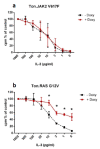Molecular Basis and Clinical Application of Growth-Factor-Independent In Vitro Myeloid Colony Formation in Chronic Myelomonocytic Leukemia
- PMID: 32842710
- PMCID: PMC7504428
- DOI: 10.3390/ijms21176057
Molecular Basis and Clinical Application of Growth-Factor-Independent In Vitro Myeloid Colony Formation in Chronic Myelomonocytic Leukemia
Abstract
We have originally reported that colony-forming units granulocyte/macrophage (CFU-GM) formation is an in vitro feature of chronic myelomonocytic leukemia (CMML) and a strong predictor for short survival. Elucidation of the molecular basis underlying this in vitro phenomenon could be helpful to define molecular features that predict inferior outcome in patients. We studied the correlation between the mutational landscape and spontaneous colony formation in 164 samples from 125 CMML patients. As compared to wildtype samples, spontaneous in vitro CFU-GM formation was significantly increased in samples containing mutations in NRAS, CBL and EZH2 that were confirmed as independent stimulatory factors by multiple regression analysis. Inducible expression of mutated RAS but not JAK2 was able to induce growth factor independence of Ba/F3 cells. Whereas high colony CFU-GM growth was a strong unfavorable parameter for survival (p < 0.00001) and time to transformation (p = 0.01390), no single mutated gene had the power to significantly predict for both outcome parameters. A composite molecular parameter including NRAS/CBL/EZH2, however, was predictive for inferior survival (p = 0.00059) as well as for increased risk of transformation (p = 0.01429). In conclusion, we show that the composite molecular profile NRAS/CBL/EZH2 derived from its impact on spontaneous in vitro myeloid colony formation improves the predictive power over single molecular parameters in patients with CMML.
Keywords: AML; CFU-GM; CMML; NGS; in vitro cultures; prognosis.
Conflict of interest statement
The authors declare no conflict of interest
Figures



References
MeSH terms
Substances
Grants and funding
LinkOut - more resources
Full Text Sources
Research Materials
Miscellaneous

